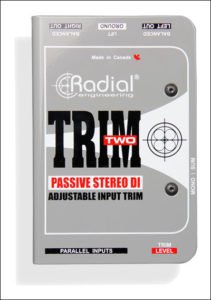Sometimes a new product is really new and sometimes it’s a refinement or an extension of an existing line. Both are new but the the second group tends to generate a little less hullabaloo. Radial’s Trim Two is definitely in that slightly less glamorous category as Radial already have a spectrum of DIs that cover just about every imaginable situation. The Trim Two is delivered in Radial’s classic and hugely effective wrap round book style casing and would stop a bullet for you without batting an eyelid. But don’t try it at home.
 The grey livery is a little dull, it has to be said, but it’s a DI not a fashion item. In the world of DI’s the transformer is king and so I have Radial’s with Jensen transformers and Cable Factory DI’s with Lundahl transformers. Radial designate products that feature Jensen transformers with a J, hence the JDI, however not all Radials have Jensen transformers. I have a Radial PRO AV2 and the AV2 features Eclipse transformers, which Radial started using when Jensen supply couldn’t keep up with demand. Eclipse and Jensen are now both part of the Radial family and Radial have invested in boosting Jensen’s output. In any case the PRO AV2 is very definitely in the Trim Two’s genealogy, or at least at first sight.
The grey livery is a little dull, it has to be said, but it’s a DI not a fashion item. In the world of DI’s the transformer is king and so I have Radial’s with Jensen transformers and Cable Factory DI’s with Lundahl transformers. Radial designate products that feature Jensen transformers with a J, hence the JDI, however not all Radials have Jensen transformers. I have a Radial PRO AV2 and the AV2 features Eclipse transformers, which Radial started using when Jensen supply couldn’t keep up with demand. Eclipse and Jensen are now both part of the Radial family and Radial have invested in boosting Jensen’s output. In any case the PRO AV2 is very definitely in the Trim Two’s genealogy, or at least at first sight.
They are both stereo devices, they both offer inputs on quarter inch jack, phonos and mini jack. They both have Eclipse transformers, they both have ground lift on the output and they both have a way of altering the gain at the input. So what is new?
Well while the PRO AV2 has a fixed 15dB pad option at the input the new Trim Two has a continuously variable pot. Now you can set the input levels exactly where you need them. Also the Trim Two has a mono option to turn your stereo source into a mono output and finally and most importantly the Trim Two is a unity gain device (give or take the inevitable insertion losses of life!) This is a function of the choice of transformers used in each device. The PRO AV2 features 12:1 transformers in mu-metal cans and inserting it into your circuit will reduce your signal level by about 20 dB. The Faraday screening provided by the mu-metal enclosures is required because we might be dealing with small signal levels. The transformers in the PRO AV2 are designed to handle signal levels from minus thirty dB up to neg ten or zero level at a push and they are described as ‘input’ transformers. The Trim Two on the other hand is designed to deal with higher signal levels from the get go. The transformers are not enclosed and with a 1:1 ratio the Trim Two expects higher signal levels and is capable of accepting a whopping +15 dB at the input. The Trim Two features ‘output’ transformers.

If your rig is stuffed with kit producing full fat audio output – keyboards, drum machines or tablets and laptops then the Trim Two is the way to go. While if you might want to chuck a guitar in the mix then the PRO AV2 will be a better choice. And so to the trim function of the Trim Two. Having a pot to alter the signal gain works with higher output devices as these usually have buffered outputs. This is important because changing the gain with a pot also changes the impedance – not a problem with a buffered output – but with instrument levels the change in impedance can result in a significant change in tone.
And the final feature to consider is the mono switch – the instruction manual shows a recessed switch that requires a screw driver to operate. I was looking forward to niggling about this inconvenience. Sadly Radial have beaten me to it and the production Trim Two has the same standard switch for mono as it does for ground lift. Nice to see a product where real world factors are taken into account in design. Having a mono switch is jolly handy when you need to save channels but at the risk of being picky I’d rather a sliding switch, sorry Radial, just because I think it’s clearer from a distance that the mono function is engaged and it is less likely to be bumped. I have no reservations about the gain trim feature, the pot is positive in action, clearly labled and isn’t going to be easily nudged. And the flexibilty of setting the levels at the input mean you can get your active gain structure just right to minimise noise.
I plugged every thing to hand into the Trim Two and from keyboards, laptops, sound cards through SQN mixers, ShortCuts and anything else lying around. Everything was interfaced without a problem. I don’t think there’s a secret to Radial’s success — they make really good products for people happy to pay a little more for exactly the right tool. And the Trim Two is another chip off the Radial block.
